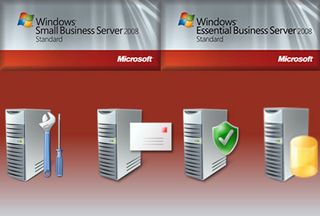ADVERTORIAL Microsoft's BPOS: Q&A for Skeptics
Filling in the Cost Comparison Blanks
In our last BPOS story, we used a cost scenario for a small business based on a 10-user operation running Small Business Server 2008. The numbers we used were somewhat back-of-the-napkin and ignored many costs, leading to an initial view that BPOS cost more per seat than running the applications on-site before secondary expenses. However, it wasn’t really an apples-to-apples analysis. SBS includes Exchange Server 2007 and SharePoint Services 3.0 while BPOS also adds Office Communications Online and Office Live Meeting. To get this functionality on site would require Office Communications Server 2007 R2, which would add another $1,000 for the server software and 10 standard CALs, plus the expense of another server system. It’s easy to lose track of just how many resources it takes to run business software.
Ignoring this oversight, we’d budgeted for one $2,500 server to run SBS 2008, and if you look up the system requirements you’ll see that, yes, Small Business Server Standard only requires one server. So we were initially stunned to run through a cost comparison tool Microsoft provided to us and learn that for 10 users the tool recommended procuring nine servers worth $45,000. Further scrutiny showed that the tool was only examining what it would take to run Windows Server 2008 in an enterprise setting. We remained confident about our small business analysis, and the enterprise calculations were obviously handled by Microsoft’s own public calculators. But what about the groups in the middle, the medium businesses needing to service more than the 75 seats covered by SBS? Why would BPOS make sense for them?

The answer is Windows Essential Business Server 2008, which is more or less the big brother to SBS, only built to cover up to 300 seats instead of 75. According to Microsoft, WEBS requires at least three servers. We’ve been budgeting $2,500 per box. Microsoft prefers to double this in its estimate tools, but we’ll stick with our number for now.
Let’s take an easy number and estimate for 100 seats. WEBS 2008 Standard costs $5,067. A pair of 50-pack CAL licenses will cost another $8,100. Add back in Office Communications Server 2007 R2 Enterprise Edition with 100 matching CALs ($3,999 plus $13,900). Bring in four servers for an even $10,000 and we’re at $41,066. Divided by 100 users and spread over three years, that’s roughly $137 per user per year, or $11.40 per month. This gets us a lot closer to the $15 per month per user for BPOS.
According to a survey by Redmondmag.com, the mean salary for base pay (before bonuses and other compensation) in the IT field is $71,988. Let’s be optimistic and assume that it only requires one IT person in a company of 100 to manage all of those business servers, applications, and users on a half-time basis. Would $35,000 annually be a fair expense for this? If so, the cost of that part-timer adds another $29.16 per user per month to our on-site costs—more than double the cost of the server hardware and software he or she is supporting. Mind you, that’s just one IT employee working part-time. Imagine what one or two full-timers does to the equation as the seat count increases. Then add in the costs of electricity each month to run those servers as well as the additional air conditioning needed for their environment.
Now think two or three years down the road when it’s time to upgrade those systems and software packages. You’re looking at another $10,000 for hardware. How much would the extra IT costs run for the platform update? $5,000? $20,000? All of that forms the monthly bottom line, and all of that disappears when the applications are hosted under an SPS model. Microsoft handles all of the IT, application support, upgrades, energy, hardware, and everything else. In a very small business environment, the question of why BPOS makes economic sense gets murky. At the mid-level, the answer seems obvious.
Check out our Microsoft BPOS Resource Center
Stay on the Cutting Edge
Join the experts who read Tom's Hardware for the inside track on enthusiast PC tech news — and have for over 25 years. We'll send breaking news and in-depth reviews of CPUs, GPUs, AI, maker hardware and more straight to your inbox.
Current page: Filling in the Cost Comparison Blanks
Prev Page Getting Physical Next Page Why Go Hosted?-
Shnur So basically it's good for the mid-size/emerging businesses? I think it's a move in the right direction, although in the current times I would like to see Microsoft focus a bit more on Small Business Solutions rather than for bigger companies, only because for the Small Businesses it's a lot harder to spend even 1000$ on something.Reply -
colemars William said: For example, in Exchange Online, there’s no more PowerShell, scripting, or similar nuances for tweaking.Reply
I understand the article is almost 2 years old, but that is a plain wrong statement. You can ceratinly use PowerShell or Migration Tool Command Shell with Exchange Online. You should update the article sir. -
colemars William said: For example, in Exchange Online, there’s no more PowerShell, scripting, or similar nuances for tweaking.Reply
I understand the article is almost 2 years old, but that is a plain wrong statement. You can ceratinly use PowerShell or Migration Tool Command Shell with Exchange Online. You should update the article sir.
Most Popular

